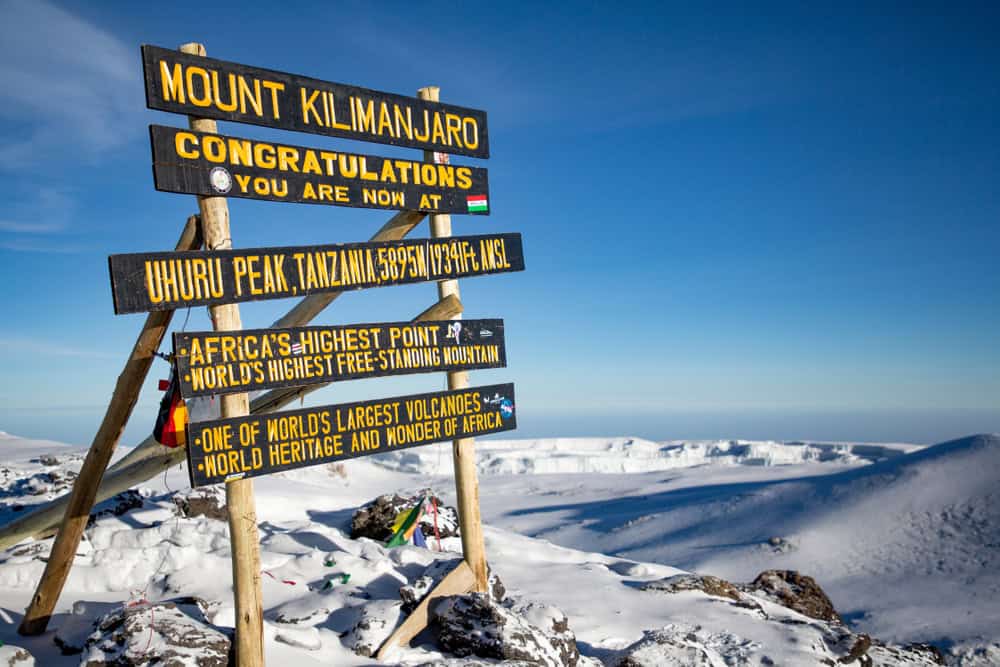Hiking the 3 highest mountains in Africa and their location
Mount Kilimanjaro
Hiking the 3 highest mountains in africa and their location, Select your route subsequent to your decision to ascend Kilimanjaro. Paths along the Northern Circuit, comprising the Lemosho, Shira, Machame (“Whiskey”), Rongai, Marangu (“Coca-Cola”), and Umbwe routes
No specialized instruments are required. During your journey to the “Roof of Africa,” you will traverse five distinct climatic zones, encountering arctic freezing temperatures adjacent to the glaciers that envelop Kibo, the summit of Kilimanjaro.
Climbing Annotations
The average temperature in Moshi is 22 degrees Celsius, but summit temperatures reach approximately -7 degrees Celsius. The primary seasons are typically from December to March and June to October. The rainy season typically occurs in April, May, and November; however, contemporary climate change has disrupted this pattern, rendering rainy season occurrences erratic. Given that the northern slope of the mountain offers greater shelter from precipitation, we persist with our Rongai ascents during rainstorms.

A favored period for ascending Kilimanjaro is during a full moon or a new moon. Kilimanjaro’s equatorial location allows for summit nights to be experienced under the illumination of a full silvery moon, eliminating the necessity for a headlamp, or beneath a sky adorned with constellations from both the northern and southern hemispheres. The Southern Cross and the North Star are both visible in the same sky from an elevated vantage point on the mountain.
Mount Kenya
Designation: Kenya
Altitude: 17,047 feet (5,199 meters)
Mountain Range: Mount Kenya Mountain Range
Nation: Kenya
Challenging Nature of Climb: Designated as a Technical Ascent
Mount Kenya, An extinct volcano ranks as the second-highest mountain in Africa. The two principal summits, Batian and Nelion, are typically blanketed with snow. Although being near the equator, Mount Kenya receives substantial snowfall annually. Unlike most other mountains of comparable magnitude in Africa, Mount Kenya is integral to the region’s ecosystem. In Kenya, it supplies potable water to about 7 million individuals. The predominant source of this is annual precipitation and snowmelt; nevertheless, there is concern that the formerly formidable glaciers and ice reserves would soon vanish.

To facilitate conservation initiatives in this area, Mount Kenya has been classified as an African World Heritage Site. It sustains a remarkable diversity of fauna, woodlands, and flora. Mount Kenya features altitudinal zones, similar to numerous other mountains in East Africa. Elephants, buffalo, lions, leopards, antelope, and several other fauna inhabit the expansive meadows, deep woodlands, and open areas of the sub-alpine zone.
Climbing aficionados and mountaineers often journey to Mount Kenya, the second-highest peak in Africa. This hike is widely considered more challenging than ascending the highest mountain on the list. It presents one of the most challenging ascents on the entire East African continent. Designated paths to the summit are accessible for rock, snow, and ice climbing for mountaineers and climbers. The Chogoria, Sirimon, and Burguret roads constitute the primary pathways.
Regrettably, Mount Kenya is among other mountains globally experiencing significant alterations in their landscape as a result of global warming and climate change. Substantial glaciers and ostensibly permanent ice formations that previously offered exceptional ice climbing prospects are progressively vanishing. Estimates suggest that it may require another ice age to restore glacial ice on African mountaintops.
Rwenzori mountains
Stanley, Uganda, and the Democratic Republic of the Congo
Designation: Stanley
Altitude: 16,794 feet (5,119 meters).
Mountain Range: Rwenzori Range
Nation: Democratic Republic of the Congo and Uganda
Ascent Difficulty: Classified as Scramble
Mount Stanley, the most powerful peak of the Ruwenzori, ranks third in height among Africa’s mountains. The three mountains create an elevated triangle that encircles the Bujuku Valley beneath, featuring Mount Speke (number 4) and Mount Baker (number 5). Margherita and Alexandra, two notable twin summits, along with other subsidiary peaks, delineate the summit.
Large glaciers from millennia before sculpted the entire region. A massive glacier once occupied the area now known as Bujuku Valley. Regrettably, only the three tallest peaks in the Rwenzori range retain observable glacial ice, and just Mount Stanley possesses any notable significance. The six tallest peaks in the range were previously enveloped by glaciers. Research indicates that the Rwenzori glaciers will be completely melted by 2025.

The Rwenzori Mountains, especially Mount Stanley, are predominantly enveloped in a constant mist, enhancing the serenity that pervades the region from the valleys to the peaks. Were it not for the two major mountains occupying the first and second spots on our list, Mount Stanley would definitely be more renowned, distinguished, and frequented.
Mount Stanley, the highest mountain of the Rwenzori Mountains, has unique challenges for trekkers as it is the sole peak featuring a genuine glacier. Due to the possibly substantial crevasses in the ice that must be crossed, a climbing rope and suitable ice climbing gear are essential.
Reports indicate that access to the peak is difficult, regardless of whether one approaches from Uganda or the Democratic Republic of the Congo. Traversing deep jungles and wetlands may require several days. Consistent with the entire mountain range, huts and shelters are situated at varying elevations, and pathways are adequately marked upon reaching the peak’s base.
